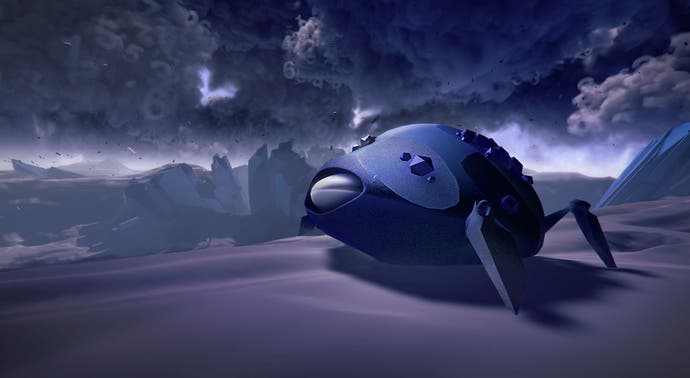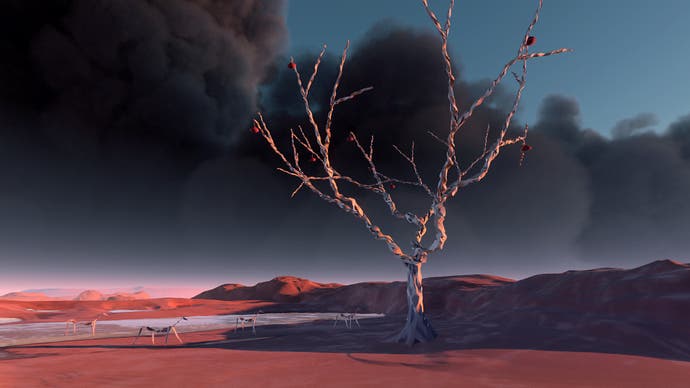Paper Beast review: a transformative VR odyssey
The Rite of Spring.
Years ago he made a game called Another World, but even now Eric Chahi's stuff always comes from another place. He's thinking about the same things other game designers think about - physics, cinema, AI, and VR in the case of his latest - but I guess he's thinking about it all in a fundamentally different way. He loves nature, but he also loves change, the juddering forces that disrupt and transform. He loves myths, but he also loves volcanoes, tidal waves, the engines of ancient memory. His gods can do astonishing things, but they ultimately have to work within the taut confines of elemental rules just like the rest of us: fire burns, water sweeps away, earth and air can be both finely grained and terrifyingly powerful.
I am wary of the idea of the auteur, and Chahi always works with a decent-sized team, but there's no questioning that distinctive themes run through all of his games. They feel personal, these games, like someone returning to a favourite thought - and they often move the thinking on a bit. Back with Another World he created a hero who's sucked through a computer screen into an alien landscape. With From Dust, he charged you with progressing across a series of inchoate environments by manipulating earth, water, air and fire. Paper Beast feels like a convergence, and a reduction. There's less of everything - there often is with VR - but the flavours you're used to are also richer.
Put on the PSVR and enter Chahi's version of cyberspace - a place you are thrust into when a simulation you've been running goes a bit awry. This place! It's prickly and lavish and extremely colourful. There are Dali deserts and Sega skies. There are crags and mountains and dunes. And jeepers! The world is alive, noble Jurassic beasts with bones made of paper and gems, origami almost-tigers and almost-horses, other things that are just ragged mops of newsprint, or maybe they're neurons shuddering around in a mass of dendrites. These animals! Their folded-paper planes beautifully invoke the jagged polygonal creations of the early days of Chahi's career.
The first one of these things you meet is a silent giant, tall and wide with bleached bracken bird's nests where its head should be. Instantly in love, I looked up and watched as it strode over me, the vaulted cathedral ceiling of its rib-cage encrusted the way Gaudi used to encrust his buildings - bits of glass and pottery scrabbled together to create something that feels like coral, that feels like it built up out of glittering sediment and took centuries to do it. Is it animal or architecture? How could I ever forget this gentle loping monster?
It's overwhelming at first. You're dropped right into the middle of a wasteland. But movement is easy - I played with the DualShock and that's teleport on one trigger, quick-turn on a thumbstick - and the design is very good at leading you without making it obvious. A splash of sunlight encourages you to move forward. A mountain looms above asking you to look up.
Interacting is easy too. Unless a beast is very big you can pick it up with the other trigger and hold it to inspect it. Using face buttons you can bring it in close or send it arcing out into the distance, and there's physics to it all too, so you can grab something close and really chuck it, or you can see something on the horizon and zip it to you. In From Dust, God was a vacuum cleaner. Here, you're not quite God anymore, and this time you've been given a fishing rod.
Ultimately, though, Paper Beast continues to explore the themes and practicalities of From Dust, which was a game about getting your followers from A to B across deadly terrain - lowering mountains, cooling lava, stemming floods. In From Dust you did that by being powerful. In Paper Beast you do it by being canny, by making use of the animals that surround you. And while that means shifting them back and forth and getting them to do what you want them to do, it also means first taking time to watch them and understand them and their relationships.
It's transformative - a game for your inner Attenborough. A typical Paper Beast level isn't complicated. There will be a hurdle to get across in the landscape, and there will be creatures nearby creaturing about. This is my favourite moment of each sequence, I think, working out where I want to get to and what's blocking me, and then just watching the wildlife, waiting for its patterns and moods and talents to make sense.

I'm going to spoil an early one. I'm deep underground and the path ahead is blocked by a sand dune. Nearby there's a creature that's covered in strands of papery hair - a sort of benign horror-show Dougal from The Magic Roundabout. After a while I notice that Dougal's hair tends to dig through the sand when he moves - he's leaving a trench behind him. Can I lure him to the dune that's blocking my path? Can I get his hair to act as a huge brush and clear the way?
There are wonderful creatures here - a sort of hovering lamp, a dung beetle but for sand, a length of pipe with two mouths and a real gift for peristalsis. They all work for you, ultimately, but none of them feel like they just work for you. They all have a bit of character to them, whether it's an initial unwillingness to move where you want them to, or a skittish nature that sees them missing the mark.
You have to use these animals in the course of the game, and you'll think about that quite a bit. Not because the game forces you to agree with its manifesto, but because it creates scenarios where you sometimes simply have to ponder what you're willing to make other things do to get you what you want. For me, Paper Beast is a game about burden and the odd things people prioritise, and most of all about interconnectedness. Ultimately, you're never really thinking about one creature on its own, but a whole biosphere of them. You're thinking about them in the context of the environment: how can I get these papery guys past heavy wind? What do these beetle things feel about water, or ice? Why do I suddenly have the power to dig trenches, and how can I get those hump-backed fellows to stop leaving sand-dunes on a path I need left open? (There's a lovely sandbox mode included with the game, but the whole thing is a sandbox TBH.)
In one level, I stole a creature's infant because I wanted it to change its direction and follow me. Did it work? Tough question. Technically, yes it worked - the creature started to follow me. But I couldn't live with what I was doing, so I reloaded and tried something less horrific. That's a pretty impressive thing for a game to do - I am at my laziest when I'm trying to solve a puzzle in a virtual space. To make me do something a little more time-consuming without imposing any explicit in-game consequences is quite something.

Because it's VR, you really live with these creatures. They are right there in the same space as you. When they're tethered and you free them, you're really the one doing the freeing. When you're up high and the path is treacherous, it really feels treacherous. This is a landscape full of fantastical surprises, but VR helps to make it feel substantial and convincing. As the game progresses you get to see this world from some surprising vantage points. This is a game with a keen eye for a sense of wonder.
What an abused word, wonder. In Chahi's world wonder is never empty or trite - it is never simply awe, which can bludgeon with mere scale or volume. Chahi's games take you from A to B because they are about the tyranny of time passing and conditions changing irrevocably. They are about things that live alongside one another but will not blend - fire and water, the analogue and the digital, stuff that cannot compromise, that must simply coexist in fighty stalemates. He loves the natural world with a reverence that contains a healthy amount of fear.
It staggers me, frankly. Those creatures and that world have left me subtly different. I will not forget them, or the sense of fascination in nature and attentiveness to one's own actions and behaviours that is at the very heart of this game. Blink at times and Paper Beasts could be mistaken for something like Journey - you cross a landscape and are transformed. But there's none of that sense of focus-testing I always got from Journey, none of that sense of beats that have been crafted purely to extract a certain response as smartly as possible. Paper Beast certainly made me feel things, but I could take you through the whole muddled thought process the game allowed for. It made me think, but it crucially allowed me to reach my own conclusions. In its final sequences, it left me profoundly unsettled, which is a very high compliment, I think.
I have played astonishing things in VR, and with the best games there's a certain sadness to it. These games are so transporting, so transformative, that you want everyone to play them. But part of the reason they work so well and do so much is that they understand the nuances of the technology - they need to be VR, which means, alas, that they are going to be niche. You should do what you can to play Paper Beast though, the same way it's worth braving a not-very-good port to play From Dust on Steam, the same way it was worth eleven hours in Economy to see the Bradbury Building. Chahi has always done things his own way. In VR, he's met a kindred spirit.



